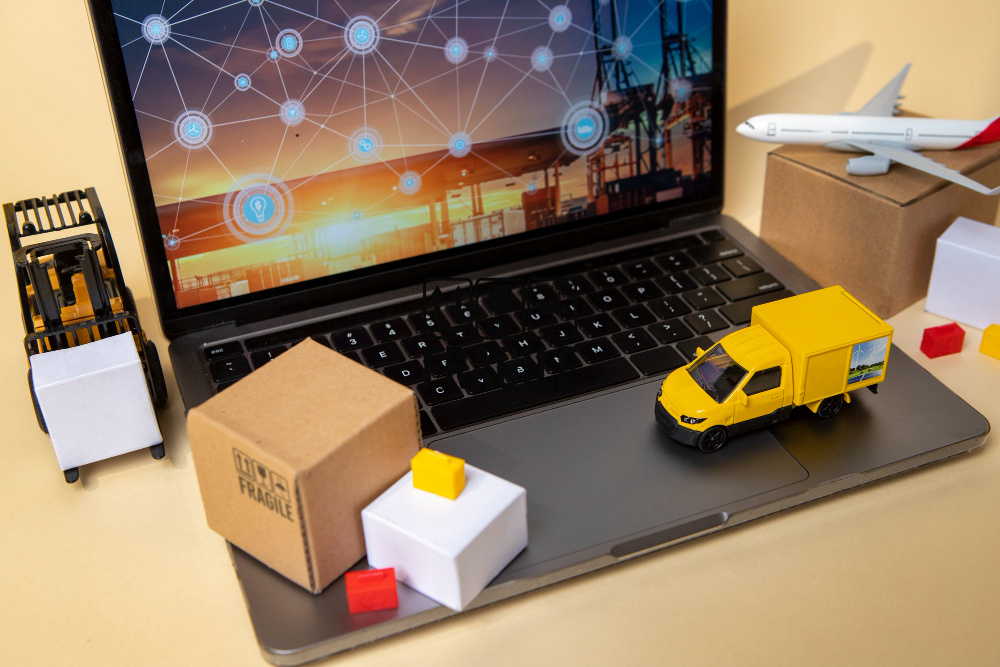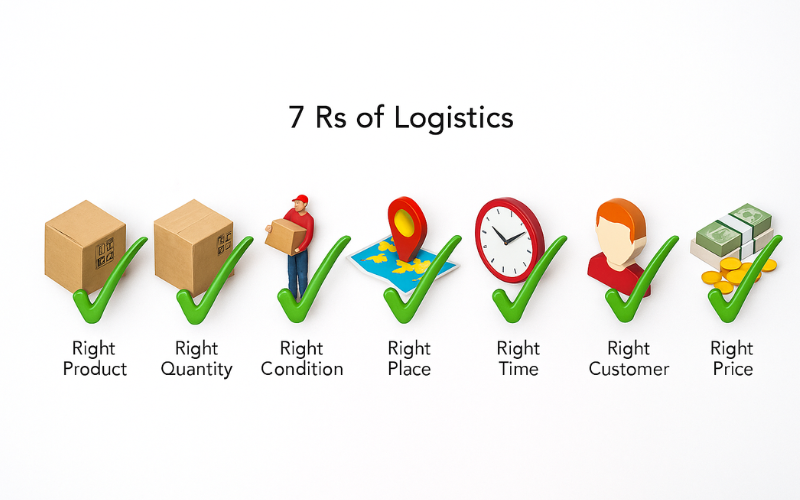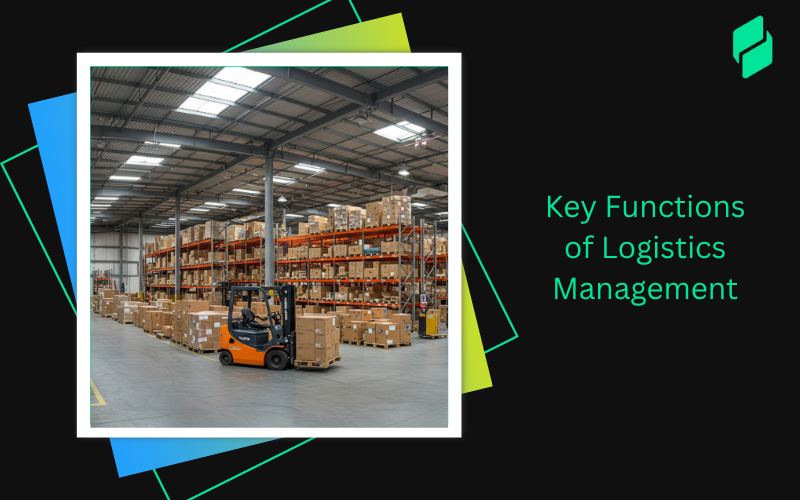Optimize your business: use unlimited savings with Pazago fulfilled now!
Get Started ->When you think about how a product gets from a manufacturer’s floor to your customer’s door, the image that comes to mind is usually a truck and a tracking number. But what really happens behind the scenes?
It’s not magic. It’s logistics management, an unsung hero that keeps your business moving, your costs in check, and your customers happy. Every product’s journey involves dozens of touchpoints, including procurement, warehousing, inventory control, transportation, and last-mile delivery. Miss one, and the whole system stalls.
A 2024 report found that businesses utilizing flexible warehouse management systems experience a 20% reduction in operational costs and a 35% improvement in order accuracy. These numbers aren't just statistics; they reflect a shift in how companies scale smart, not just fast.
If you’ve ever asked yourself, “Isn’t logistics just shipping?” this one’s for you. Let’s explore everything, from the basics to the fine-tuned functions that make this process work smoothly.
TL;DR
- Logistics management is the backbone of supply chain success, coordinating order processing, inventory, warehousing, transportation, and last-mile delivery to ensure timely, cost-effective product movement.
- Flexible warehouse management systems can reduce operational costs by 20% and improve order accuracy by 35%, highlighting the impact of smart logistics on scaling business efficiently.
- Core functions include inbound/outbound logistics, material handling, packaging, network design, and information systems, all working together to reduce delays, minimize costs, and boost customer satisfaction.
- Real-time visibility and digital tools like WMS and TMS empower proactive decision-making, improving performance across every logistics step, from procurement to returns.
What is Logistics Management?
Logistics management involves planning, executing, and controlling the movement and storage of goods, services, and related information across the supply chain, from origin to destination. It ensures products are delivered efficiently, cost-effectively, and in good condition.
At its core, it aligns supply with demand by managing key operations like transportation, warehousing, inventory, packaging, and order fulfillment. These functions of logistics management work together to simplify delivery.
When done right, logistics reduces costs, prevents stock issues, and improves customer satisfaction. In short, it ensures the right product reaches the right place at the right time, in the right condition, at the lowest possible cost.
Now that we know what logistics management is, let us explore its functions in the delivery process below.
Also Read: Understanding the Importance and Definition of Supply Chain Visibility
Functions of Logistics Management

The functions of logistics management ensure that goods move through the supply chain efficiently from the point of origin to the end customer. These functions help reduce costs, minimize delays, and maintain service quality. Here are the key functions explained:
1. Order Processing
This is where logistics begins. It involves verifying order details, checking stock availability, initiating picking and packing, and confirming shipment. A fast, accurate process reduces lead time and avoids delivery errors.
2. Inventory Management
Managing inventory means keeping the right stock at the right time. This includes tracking stock levels, setting reorder points, and forecasting demand. Poor inventory control leads to stockouts, overstocks, or missed sales opportunities.
3. Warehousing
Warehousing is more than storage. It focuses on accessibility, security, and speed. A well-organized warehouse improves picking accuracy, reduces handling time, and supports faster order fulfillment.
4. Transportation
Transportation ensures goods are moved safely and on time. This includes selecting carriers, planning optimal routes, scheduling deliveries, and monitoring in-transit shipments. Efficient transport reduces costs and improves delivery reliability.
5. Material Handling
This covers the movement of goods within warehouses or between loading points. Using the right equipment such as forklifts and conveyors minimizes product damage, reduces labor effort, and speeds up operations.
6. Packaging
Packaging protects goods during storage and transit. It must be durable, cost-effective, and optimized for space and weight. Good packaging also supports branding and meets regulatory requirements.
7. Logistics Network Design
This involves deciding where to locate warehouses, distribution centers, and transport hubs. A strategic network design cuts delivery times, reduces fuel costs, and supports future expansion.
8. Information and Control Systems
Digital tools like Warehouse Management Systems (WMS) and Transportation Management Systems (TMS) offer real-time visibility, automate processes, and enable better decision-making across the supply chain.
9. Demand Forecasting
Accurate forecasting helps align inventory, procurement, and shipping plans with market demand. It reduces the risk of stockouts or excess stock and keeps operations responsive to customer needs.
10. Customer Service
Customer service in logistics includes shipment updates, handling returns, and resolving delivery issues. Strong logistics support improves customer satisfaction and builds brand loyalty.
Now that we know the functions of logistics management, let us discuss why it is essential for businesses.
Suggested Read: Understanding the Components and Benefits of Reverse Logistics
Importance of Logistics Management

Logistics management supports smooth operations, reduces costs, and helps meet customer expectations. Here’s how:
- Better Transportation Planning: A core function of logistics management is selecting the best route, carrier, and mode of transport to reduce costs and avoid delivery delays.
- Accurate Inventory Control: By tracking stock in real-time, logistics helps prevent overstocking and stockouts, keeping storage costs in check and ensuring product availability.
- Supply Chain Visibility: Real-time tracking across every stage of delivery helps teams respond quickly to issues and keep operations running without disruption.
- Improved Customer Satisfaction: Timely deliveries and accurate order fulfillment lead to better customer experiences and stronger brand loyalty.
- Cost and Resource Efficiency: Efficient logistics reduces waste, improves warehouse space use, and ensures smarter scheduling of labor and vehicles.
- Risk and Compliance Management: Logistics teams plan for delays, monitor compliance, and handle shipping documentation to avoid costly errors.
- Sustainable Practices: Modern logistics includes route optimization and eco-friendly packaging to reduce carbon emissions and support sustainability goals.
Now that we know the functions and importance of logistics management, let us discuss its types below.
You Might Also Like: Key Elements of Implementing a Logistics Management System
Types of Logistics Management
Each type of logistics management focuses on a specific area within the supply chain. Understanding these types helps businesses structure operations more effectively.
- Inbound Logistics: Deals with the movement of raw materials and goods from suppliers to your business. It includes procurement, transport, receiving, and storage of materials.
- Outbound Logistics: Focuses on delivering finished goods from your business to the end customer. It covers order fulfillment, packaging, distribution, and shipping.
- Third-Party Logistics (3PL): Involves outsourcing logistics functions such as warehousing, transportation, and fulfillment to specialized providers. This allows businesses to scale without investing heavily in infrastructure.
- Reverse Logistics: Manages the flow of goods back from the customer to the seller or manufacturer, often for returns, repairs, recycling, or disposal.
- Distribution Logistics: Focuses on moving goods through the distribution network efficiently. This includes managing regional warehouses, distributors, and retail channels.
- Green Logistics: Prioritizes sustainability by minimizing the environmental impact of logistics activities. It includes using energy-efficient transportation, reducing packaging waste, and optimizing delivery routes to cut emissions.
So, what are the 7 Rs of logistics that businesses follow? Let us understand in detail below.
Also Read: How Logistics Operations and Supply Chain Works
7 Rs of Logistics

The 7 Rs of logistics represent the core principles that guide successful logistics and supply chain operations. Each "R" focuses on delivering maximum value while minimizing cost and waste. Here’s a closer look at each:
- Right Product: Ensuring the correct product is available to meet customer needs. This involves accurate inventory management, product identification, and demand forecasting to avoid stockouts or overstocking.
- Right Quantity: Delivering the exact quantity required, no more, no less. Accurate order picking and efficient warehouse operations help maintain optimal stock levels, reduce holding costs, and prevent order discrepancies.
- Right Condition: Products must arrive in perfect condition. Proper packaging, storage, and transportation safeguard goods from damage, spoilage, or loss. This is especially critical for perishable or fragile items.
- Right Place: Getting the product to the intended destination without delay. Effective route planning, GPS tracking, and distribution network optimization ensure timely deliveries to warehouses, retailers, or customers.
- Right Time: Timeliness is everything in logistics. Meeting delivery schedules, whether just in time or pre-planned, boosts customer satisfaction and keeps production or sales operations running smoothly.
- Right Customer: Delivering the order to the correct recipient, as specified in the shipping and billing details. Accuracy here reduces returns, re-shipments, and customer service complaints.
- Right Cost: Balancing service quality with cost efficiency. This involves negotiating favorable freight rates, optimizing shipment methods, and avoiding unnecessary expenses. Ultimately, this protects profit margins.
That leads us to the steps for managing logistics in business. Let us understand the steps with clarity below.
Steps to Manage Logistics

Logistics is all about moving products efficiently from point A to point B. However, behind the scenes, a series of well-coordinated steps keeps everything running smoothly.
Here’s how the process typically unfolds:
1. Planning and Forecasting
Every logistics operation starts with planning. This involves demand forecasting, inventory planning, route mapping, and scheduling. The goal is to anticipate customer needs, balance supply and demand, and avoid bottlenecks or delays.
2. Procurement and Inbound Logistics
This step covers the sourcing and transportation of raw materials or goods from suppliers to your facility. One of the most critical functions of logistics management, inbound logistics ensures that materials arrive on time and in the right quantities, minimizing stockouts and overstocking.
3. Inventory Management
Once products arrive, they must be stored efficiently. Inventory control includes tracking stock levels, managing warehousing space, and reducing holding costs. Proper inventory management avoids shrinkage, improves order fulfillment speed, and ensures stock accuracy.
4. Warehousing and Storage
This involves storing goods safely and organizing them for easy access. A well-run warehouse supports faster picking, packing, and shipping, key contributors to customer satisfaction. It also plays a vital role in managing returns and reverse logistics.
5. Order Fulfillment
Once an order is placed, logistics kicks into action. This function includes picking the product from inventory, packing it securely, labeling it, and preparing it for shipment. It also involves tracking order status and handling exceptions, such as delivery failures or delays.
6. Transportation Management
Efficient transportation is a cornerstone of successful logistics. This function focuses on selecting the right carrier, optimizing delivery routes, consolidating shipments, and monitoring carrier performance. It's where cost savings and delivery speed must be balanced.
7. Last Mile Delivery
The final stage is often the most challenging. Last-mile delivery involves getting the package from a distribution center to the end customer. Real-time tracking, route optimization, and reliable carrier partnerships are crucial here to reduce delays and ensure a smooth experience.
8. Returns and Reverse Logistics
Handling product returns, exchanges, and recycling is an often-overlooked part of the logistics chain. Managing reverse logistics well helps recover value from returned items and builds customer trust.
9. Performance Monitoring and Optimization
Logistics management doesn't stop at delivery. Analyzing key metrics like delivery time, fulfillment rate, transportation costs, and inventory turnover helps identify gaps and continuously improve the process.
With the steps and logistics in place, let's move on to discuss the tips for managing logistics effectively for your business.
Suggested Read: Logistics Invoice Template Format
Tips for Effective Logistics Management

Managing the functions of logistics management, like transportation, warehousing, and inventory control, takes more than just coordination. It requires smart tools, solid processes, and a proactive team. Here’s how to make it work:
- Use Tech for Real-Time Visibility: Use tools like TMS, WMS, and GPS tracking to monitor shipments, inventory, and warehouse performance in real time. This minimizes delays and improves decision-making.
- Stay on Top of Inventory: Use demand forecasting to avoid overstocking or stockouts. Align inventory levels with actual sales to support one of the core functions of logistics management.
- Strengthen Carrier and Supplier Ties: Build strong relationships with vendors. Clear communication and well-defined SLAs lead to smoother transportation and procurement.
- Improve Warehouse Efficiency: Organize warehouse space with smart layouts and automation. Standardize processes to cut down on errors and speed up order fulfillment.
- Optimize Last-Mile Delivery: Use route planning and tracking tools to manage last-mile challenges. Offer flexible delivery options to keep customers happy.
- Train and Upskill Your Team: Equip staff with the right skills and tools. A knowledgeable team ensures every logistics function runs smoothly.
- Track KPIs and Adapt: Monitor metrics like delivery time, accuracy, and return rates. Regular reviews help you fine-tune each function of logistics management for better results.
Logistics management plays a crucial role in business, and managing it effectively at every stage of delivery is essential. That is where Pazago comes in. So, how does it help you?
How Pazago Helps You Stay in Control of Every Delivery Stage
Managing logistics is about more than just moving goods. It’s about ensuring speed, accuracy, and reliability across every delivery step. Here’s how Pazago supports the key functions that keep your logistics running smoothly:
- Real-Time Tracking: Know where your shipments are at all times. Pazago offers live tracking and centralized visibility, helping you monitor delays, update customers, and stay in control.
- Centralized Documentation: Avoid delays caused by missing paperwork. Pazago stores all shipping documents in one place to reduce errors and simplify compliance.
- Risk Management: Shipments face risks in transit. Pazago provides built-in insurance options and an easy claims process to protect your cargo and reduce losses.
- Smooth Communication: Pazago connects your team, carriers, and partners with real-time messaging tools so everyone stays informed and aligned.
- Quality Checks: Ensure your products meet standards before shipping. Pazago digitizes inspection workflows to help you avoid rejections or disputes.
- Simplified Payments and Compliance: Pazago streamlines cross-border payments, handles currency conversion, and helps you stay compliant with global shipping regulations.
Good logistics means fewer delays, fewer errors, and happier customers. Pazago gives you end-to-end support to help you move faster, stay compliant, and deliver better.
Conclusion
The functions of logistics management are not just about getting packages from point A to point B. It’s about creating a system that works reliably, efficiently, and at scale. When these functions run smoothly, businesses see fewer delays, lower costs, and stronger customer satisfaction. But when they don’t, even small issues in routing, inventory, or communication can snowball into lost revenue and reputational damage.
As the logistics landscape evolves, businesses are turning to digital tools to increase control and visibility across the supply chain. Platforms like Pazago help make that shift easier. With features such as centralized shipment tracking, real-time updates, and automated dispatching, Pazago simplifies daily logistics operations so teams can focus on growth instead of problem-solving.
If you're looking to strengthen your logistics foundation and reduce friction in your supply chain, tools like Pazago can help you stay ahead. Want to see how it works? Book a demo today.
FAQs
1. What are the main functions of logistics management?
Ans. Logistics management involves planning, implementing, and controlling the efficient flow and storage of goods, services, and related information from the point of origin to the point of consumption. Key functions include transportation management, inventory control, warehousing, order fulfillment, and demand forecasting.
2. Why is logistics management important for businesses?
Ans. Effective logistics management reduces operational costs, improves customer satisfaction by ensuring timely delivery, enhances supply chain visibility, and provides an edge by optimizing resource use and minimizing delays.
3. How does logistics management impact customer experience?
Ans. Logistics management ensures products are delivered on time, in good condition, and to the right place. This reliability builds customer trust, supports repeat business, and enhances overall satisfaction with the brand.
4. What role does technology play in logistics management?
Ans. Technology, such as GPS tracking, warehouse management systems (WMS), and transportation management systems (TMS), improves accuracy, speeds up processes, enables real-time tracking, and supports data-driven decisions in logistics operations.
5. How can small businesses benefit from effective logistics management?
Ans. Even small businesses can reduce costs, improve delivery speed, and increase customer satisfaction through proper logistics management. Streamlined inventory and transportation reduce waste and enable better scalability as the business grows.


.png)








